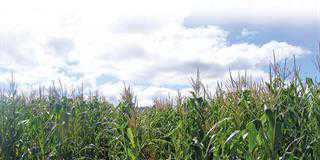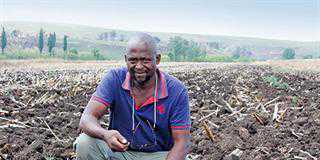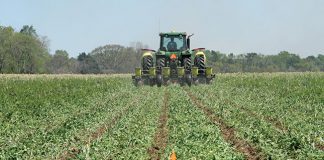Conservation farming is an important agricultural practice for ensuring economic survival in the Southern Cape’s tough climate. For Neels Uys from the farm Skeiding near Heidelberg, periodic crop failure is a part of life in this area, with its erratic rainfall.
“We can count on a poor rainy season every three to four years,” he says. “To address this risk, most farmers have diversified their production to include an animal and a grain element. They’ve also adopted conservation farming practices such as minimum tillage and crop rotation to improve soil health and increase the soil’s water holding capacity and resilience.”
No-till has always been the ultimate goal for these farmers, but with no suitable planters to plant in thick residue, they have been restricted to minimum tillage. According to Neels, a disc planter is ideal, but those available in South Africa up to now have been too light to penetrate thick residue.
“Tine planters were the only viable alternative, disturbing the soil only slightly, but we still had to distribute the residue evenly before planting. Some farmers tried to achieve this by pulling tyres over the lands, while other used a harrow. In other parts of the country, farmers have even resorted to burning the residue.”
The solution came about a year ago when Neels’ brother Pietie, who farms on Kliprivier near Swellendam, watched a YouTube video on cover crops and the Tobin Bullet disc planter. Pietie heard the sound of a pebble hitting the planter’s disc and was impressed by the ease with which the huge disc moved though the heavy stover. He persuaded Lourens van Eeden from the farm Vleitjie near Swellendam to accompany him to Australia to look at the implement.
They liked what they saw, so together with Neels, they imported a unit and tested it under local conditions. They were so impressed with the results that they acquired the distribution rights for South Africa at the start of the planting season in April this year.
Planting in lucerne
The Tobin Bullet disc planter is heavier than any other disc planter available in South Africa. It weighs approximately one ton for each metre of working width, which means that an 8m planter weighs about 8t. Disc break-out can be set from the cabin at between 30kg and 320kg per disc, allowing the planter to penetrate soil in conditions ranging from residue built-up due to years of no-till, to stony pasture. This is not possible with a lighter machine.
The planter has the largest discs available in South Africa, enabling it to move easily through thick residue and prevent hairpinning. This occurs when a planter with smaller discs pushes the residue forward so that it piles up in front of the discs, preventing the planter from moving through it. The Tobin Bullet’s discs are 610mm in diameter, 6mm thick, and angled at 3,5° in the direction of travel.
Since it can move easily through pasture, the planter allows Southern Cape farmers to plant a variety of forage crops into lucerne. Farmers typically have a five-year forage cycle, followed by a grain rotation of five to six years, in which canola, lupins or barley are planted.
“We couldn’t plant anything into lucerne because the available planters would have damaged the lucerne,” says Hoppies Uys, Pietie’s son, who assists him with the farming.
“The Tobin Bullet enables us to plant forage crops such as oats, triticale, legumes, lupines and barley into the lucerne, extending the period we can feed livestock on the farm.”
Crop diversity
A diversity of crops in the forage cycle reduces production risk and improves soil health. Hoppies explains that each forage crop helps to break the lucerne monoculture cycle, and brings its own benefit. Triticale, for example, is a hardy crop with an aggressive root system that binds light soils better than wheat, barley or oats, helping to aerate the soil and improve soil structure. Barley’s ability to suppress diseases is especially valuable. Legumes such as faba beans and sweet clover fix nitrogen through their beneficial relationship with Rhizobium bacteria and supply nitrogen to the crops that follow, stimulating biological activity in the soil.
No-till
Unlike a tine planter, the Tobin planter’s soil disturbance is less than 20%, which qualifies it as a no-till implement. The minimal disturbance of the soil structure also improves the soil’s water-holding capacity, which is a priority for Southern Cape farmers. The planter also reduces farmers’ costs, while saving time and labour. Neels’s fuel bill has been reduced by more than 30% as he no longer needs to do stubble management before planting.
Due to its rolling ability, the planter requires 30% less pulling power than a tined implement. A tractor with a capacity of 150 kW to 180 kW can be used to pull an 8,5m Tobin planter with 28 discs, while between 5,3kW and 6,5kW per disc is required to operate the planter on steep hills and only 3,75kW on level ground, explains Hoppies.
Under ideal conditions, it can plant at 16km/h to 22km/h but so far it has been used to plant at only 8km/h to 10km/h. A tine planter usually plants at 5km/h to 7km/ h. According to Neels, the Tobin planter’s planting speed should improve to 10km/h or 11km/ h in the next season as they become better acquainted with it. This speed will not apply in stony soil, however.
Uniformity
Plant depth and pressure are controlled from the tractor cab to ensure that seed is placed at the predetermined depth
– 4cm to 4,5cm for wheat – irrespective of the speed. This results in more uniform germination than is possible with a tine planter. Fertiliser is placed along with the seed.
“We typically use a low volume of fertiliser during planting, 15 units of nitrogen/ha, five units of phosphate/ha, and six units of potassium/ha,” Hoppies explains. “The risk of seed burning is lower than with 30 units to 40 units of nitrogen/ ha. A system which band-places nitrogen separately alongside the seed can also be fitted to the planter.”
The group has used the planter on many farms in the Southern Cape since the start of the planting season. There are currently three in operation in the country: one in the Western Cape near Eendekuil and two in the southern Cape near Heidelberg.
The planter can also be custom-designed for a user at an additional cost of R43 000 to R50 000 per disc, Neels says. “The row spacings are 305mm, 325mm and 380mm, with working widths from 3,6m to 22m in 1,2m increments.” A second model, the Tornado Tobin disc planter will be on show at Agri Mega in September.
While the Tobin Bullet planter is a single-row implement, the Tornado is a double-row disc machine with row spacings of 175mm to 450mm. The Tornado follows contours more closely than the Bullet and is ideal for planting seed in legume or grass pasture Noel Tobin, managing director of Tobin No-Till in Australia, says the Tornado is more suitable than the Bullet for use in conjunction with the grass herbicide, trifluralin.
“While this might be true for Australia, using trifluralin with the Tornado still has to be tested under SA conditions,” Neels cautions. The Tornado is available in any width and can also be customised. An 8,5m to 9m machine would be ideal for a 1 000ha farm, whereas a farmer with a property larger than 1 500ha may be better off with two machines like these, or one 20m machine. Smaller farmers can pool resources and share a machine.
Neels says the investment is more than worthwhile in terms of the planter’s fuel and time savings, as well as its valuable contribution to improving soil health and conservation farming practices.
Phone Neels Uys on 082 440 0242 or email [email protected].













